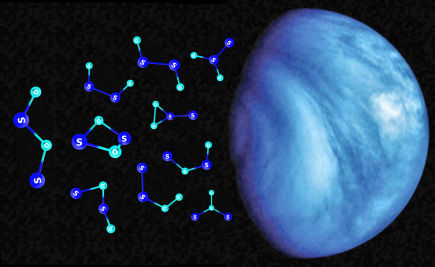S2O2q+ (q=0,1,2) Molecular Systems: Characterization and Atmospheric Planetary Implications
[Bibtex]
@article{
author = {Majdi Hochlaf*, Roberto Linguerri, Mohamed Cheraki, Tarek Ayari, Ridha Ben Said*, Raimund Feifel, and Gilberte Chambaud*},
title = {S2O2
q+ (q=0,1,2) Molecular Systems: Characterization and Atmospheric Planetary Implications},
journal = {Journal of Physical Chemistry A},
volume = {125},
number = {1958-1971},
abstract = {},
year = {2021},
type= {Article},
}- DOI number: 10.1021/acs.jpca.0c11407
- Corresponding authors contact e-mails: M. Hochlaf (hochlaf@univ-mlv.fr), R. Ben Said (ben.said.ridha@gmail.com), G. Chambaud (gilberte.chambaud@u-pem.fr)
The physico-chemistry of sulfur oxides in the atmosphere of Venus is not well understood. In addition to SO2 and SO oxides, several other sulfur oxides may exist and may be responsible for the near-UV absorption in Venus atmosphere. At present, we use precise ab initio post Hartree-Fock methodologies including standard and explicitly correlated coupled cluster and multi reference configuration interaction to study the electronic structure, relative stability, electronic excited states and spectroscopy of stable isomers of neutral, positively and doubly charged [S2O2] system, with particular emphasis on the most relevant isomers that could be involved in planetary atmospheres.
Several stable isomers were characterized, several for the first time, in particular for ionic species. Calculations show that in addition to the cis-OSSO and trans-OSSO proposed for near UV absorption of the Venusian atmosphere, other S2O2, S2O2+, and S2O22+ species may contribute. Furthermore, we give a set of energetics including adiabatic ionization energies and fragmentation energies that can be used for their identification by mass spectrometry and UV spectroscopy in the laboratory or in planetary atmospheres. In sum, our work shows that nature of molecular species responsible for the near-UV absorber of Venus is not definitely established yet.
